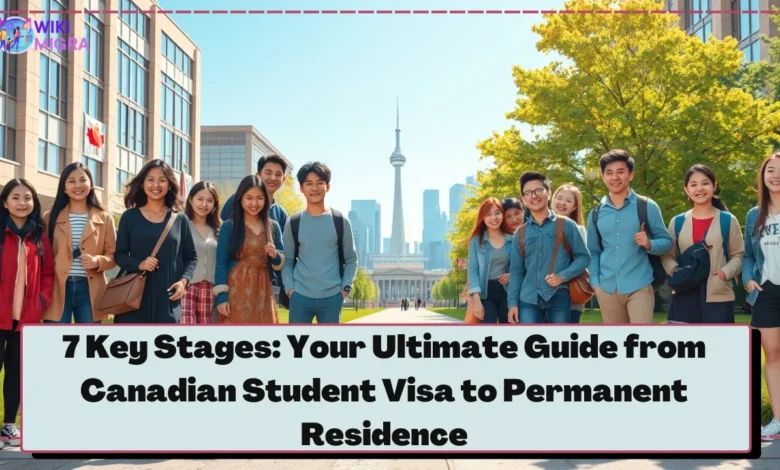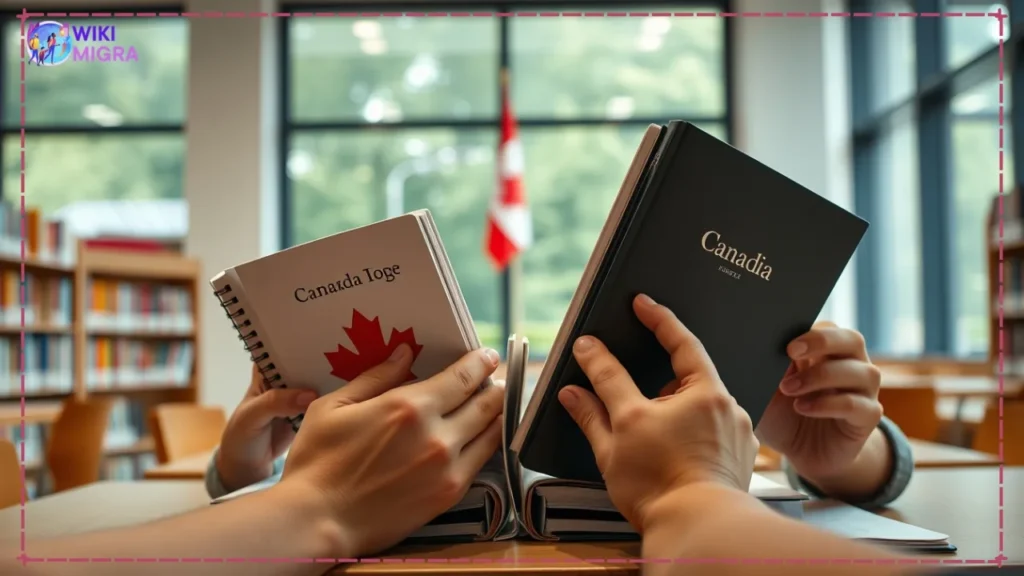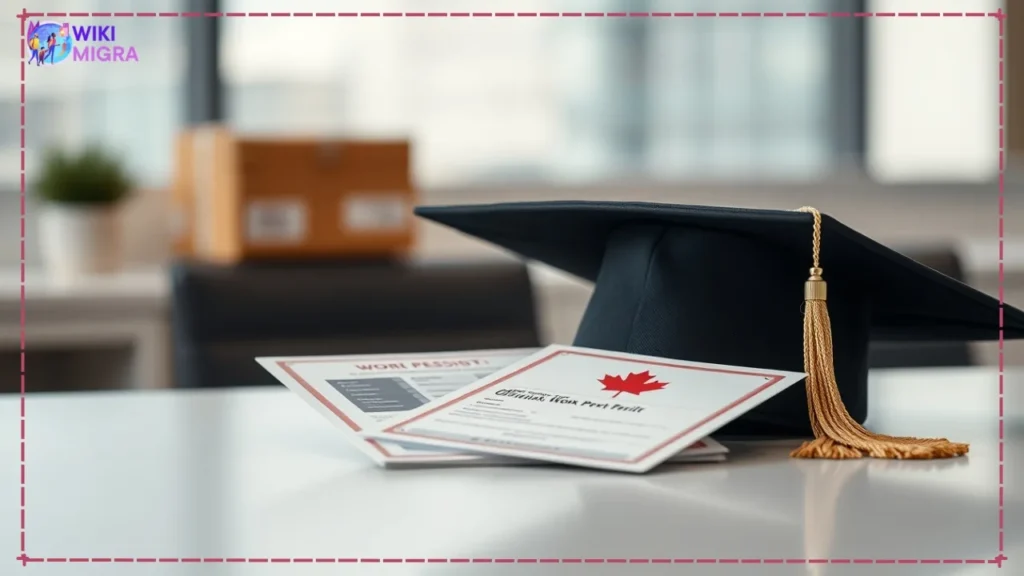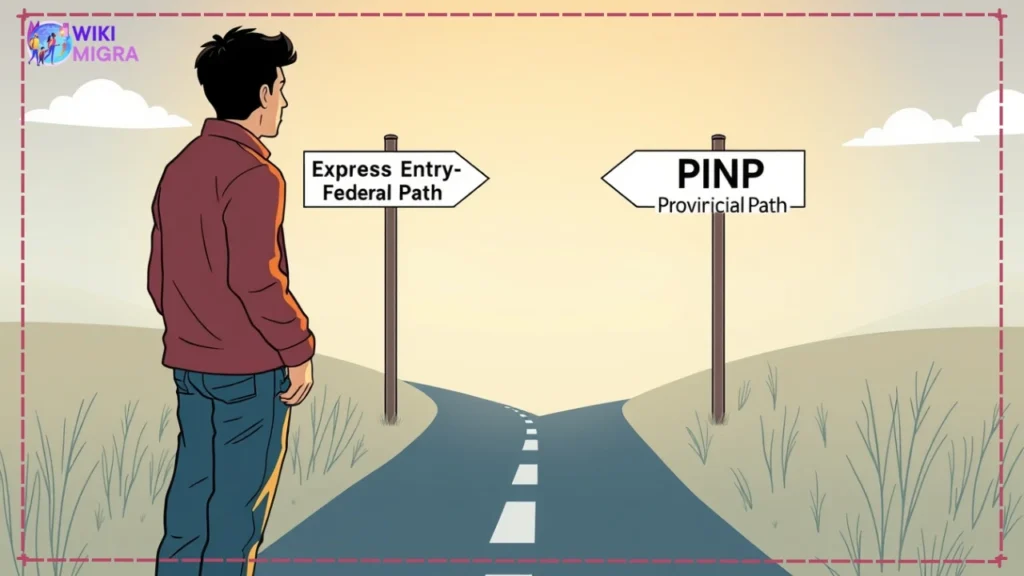7 Key Stages: Your Ultimate Guide from Canadian Student Visa to Permanent Residence

So, you came to Canada with dreams bigger than just graduation day. You envisioned building a life here, contributing to the community, and eventually calling the Great White North home. You’re not alone. Thousands share this aspiration, actively seeking the pathway from a Canadian student visa to permanent residence. It’s a significant goal, representing a major life transition. While it’s a well-trodden path for many international graduates, let’s be honest – figuring out how to get PR after studying in Canada can feel like navigating a complex maze with high stakes.
The fantastic news? Achieving permanent residency after your studies is absolutely possible! The journey from a Canadian student visa to permanent residence involves distinct stages, specific requirements, and several potential routes tailored for skilled individuals like you. Success demands careful planning, meticulous attention to detail, and staying informed about the latest rules governing canadian immigration for international students. This guide is designed to be your comprehensive compass, simplifying the complexities and empowering you with the knowledge needed to turn your Canadian dream into reality. We’ve compiled extensive, up-to-date information, drawing on official sources and breaking down the process step-by-step, focusing specifically on the Canadian student visa to permanent residence transition.
In this ultimate guide, we’ll walk you through the 7 key stages of moving from a Canadian student visa to permanent residence:
- Laying the Foundation: Understanding Your Study Permit’s Role.
- Building the Bridge: Leveraging the Post-Graduation Work Permit (PGWP Canada).
- Gaining Traction: Securing Crucial Canadian Work Experience for PR.
- Choosing Your Route: Exploring Express Entry for students & PNP for international students.
- Meeting the Criteria: Understanding Key PR Requirements After Studying.
- The Final Stretch: Navigating the PR Application Process.
- Avoiding Pitfalls: Common Mistakes & Pro Tips for your study in Canada permanent residence goal.
Ready to map out your detailed plan for transitioning from a Canadian student visa to permanent residence? Let’s begin this important journey.
Stage 1: Your Foundation – The Canadian Study Permit

Everything starts here. Your study permit isn’t just permission to attend classes at a Designated Learning Institution (DLI); it’s the foundational document for your entire Canadian student visa to permanent residence journey. Think of it as your entry ticket and the rulebook for your initial stay – following these rules is paramount for future success.
Its primary purpose is clear: to allow you to study legally in Canada at a specific Designated Learning Institution (DLI) for a defined period. However, it comes with crucial conditions you must adhere to. Non-compliance can seriously jeopardize your future applications related to canadian immigration for international students, including your eligibility for a PGWP and subsequent PR applications. Failing to comply can unfortunately halt your Canadian student visa to permanent residence plans before they truly begin.
Key Considerations for Compliance (Crucial for Future PR):
- Enrollment Status: You must remain enrolled at your DLI and be actively pursuing your studies towards completion. Dropping out or switching to part-time studies (unless permitted in your final semester) can violate permit conditions and impact your study in Canada permanent residence eligibility later.
- Work Allowances: Most full-time international students can work off-campus (up to 20 hours/week during regular sessions, full-time during scheduled breaks) if their study permit authorizes it. Unauthorized work is a major violation and can make you inadmissible. (Always verify current work hour policies via IRCC, as temporary measures sometimes exist).
- Authorized Leave: Any study breaks longer than 150 days must be formally authorized by your DLI.
- Permit Validity: Meticulously track your study permit’s expiry date. You must apply for an extension, a different permit (like a PGWP), or leave Canada before it expires to maintain your status – essential for a smooth Canadian student visa to permanent residence transition.
Understanding and respecting these conditions isn’t just bureaucratic; it’s about actively safeguarding your pathway how to get PR after studying in Canada.
Official Resource: For the most current and detailed information on study permit conditions, always refer to the official Immigration, Refugees and Citizenship Canada (IRCC) website: Official IRCC Study Permit Conditions Page
Stage 2: The Bridge to Work – The Post-Graduation Work Permit (PGWP)

Graduation! A huge milestone. Now, what’s the next step towards permanent residency? For most international students aiming for the Canadian student visa to permanent residence goal, the absolutely vital next step is securing a Post-Graduation Work Permit (PGWP). The PGWP Canada program is specifically designed as this crucial bridge, allowing eligible graduates like you to gain valuable Canadian work experience – a cornerstone requirement for many permanent residence pathways.
What is a PGWP? It’s an open work permit. This powerful permit allows you to work for almost any employer, anywhere in Canada (with few exceptions), without your employer needing a Labour Market Impact Assessment (LMIA). This flexibility is invaluable for finding the skilled work required for the next stage of your Canadian student visa to permanent residence journey.
Why is PGWP Canada Vital for PR?
Most economic canadian immigration for international students programs, especially the popular Canadian Experience Class (CEC), heavily favour or mandate skilled Canadian work experience. The PGWP Canada provides the necessary legal authorization and timeframe (up to 3 years) to acquire this critical experience right after graduation. Without a PGWP, legally gaining the Canadian work experience needed for the Canadian student visa to permanent residence transition becomes significantly more difficult.
PGWP Eligibility Requirements
Eligibility for PGWP Canada is strict and non-negotiable. You must meet all criteria:
- Eligible DLI & Program: Completed a study program (at least 8 months) at a PGWP-eligible DLI. Verify your DLI’s eligibility early!
- Full-Time Study: Maintained full-time student status during each academic session (exceptions for final session/authorized leave).
- Program Completion: Received written confirmation (final transcript, official letter) from your DLI confirming you’ve met program requirements.
- Application Timing: Apply within 180 days of receiving that written confirmation from your DLI. This deadline is firm.
- Valid Status: Held valid temporary status (e.g., study permit) when applying or applied from abroad within the 180-day window. Maintaining status is key for a smooth Canadian student visa to permanent residence process.
PGWP Validity (How Duration is Calculated)
The length of your PGWP Canada permit generally aligns with your study program’s duration:
- < 8 months: Not eligible.
- 8 months to < 2 years: PGWP length usually matches program length (e.g., 1-year program ≈ 1-year PGWP).
- ≥ 2 years: Maximum PGWP validity of 3 years.
- Multiple Programs: May combine lengths up to 3 years maximum if criteria are met.
A longer PGWP provides a crucial advantage in gaining the required experience for the Canadian student visa to permanent residence pathway.
How and When to Apply for PGWP
- Timing: Apply within 180 days of official program completion confirmation. Don’t delay!
- Method: Typically apply online via your IRCC secure account.
- Documents: Passport, final transcript, official DLI letter are usually required. Check IRCC for the full list.
- Maintained Status: Applying from within Canada before your study permit expires grants “maintained status,” allowing full-time work while awaiting the PGWP decision – a huge benefit for continuing your Canadian student visa to permanent residence journey without interruption.
Pro Tip: DO NOT let your study permit expire before applying for your PGWP from within Canada! Applying with a valid study permit enables maintained status, letting you work full-time immediately post-studies while your PGWP application is processed. An expired permit complicates things immensely, potentially requiring status restoration or leaving Canada, disrupting your Canadian student visa to permanent residence plans.
PGWP Eligibility Flowchart Outline
Start →
1. Did you graduate from a Designated Learning Institution (DLI)?
➡️ No → Not Eligible
➡️ Yes →
2. Was your program at least 8 months long?
➡️ No → Not Eligible
➡️ Yes →
3. Did you study full-time in each academic session?
➡️ No → Not Eligible (with some exceptions, e.g., final semester)
➡️ Yes →
4. Do you have valid status (or have you restored it)?
➡️ No → Not Eligible
➡️ Yes →
5. Did you apply for the PGWP within 180 days of receiving final marks or transcript?
➡️ No → Not Eligible
➡️ Yes →
✅ Eligible for PGWP
Official Resource: Get the latest PGWP Canada details directly from IRCC: Official IRCC PGWP Page
Stage 3: Gaining Crucial Canadian Work Experience

Armed with your PGWP Canada permit, the next phase is pivotal for your Canadian student visa to permanent residence goal: acquiring relevant Canadian work experience. This isn’t just about income; it’s about building the professional foundation required for most economic canadian immigration for international students pathways. IRCC places high value on applicants who demonstrate successful integration into the Canadian labour market – a key indicator for long-term success.
Why Canadian Work Experience is Key for the Student-to-PR Path:
- Eligibility Requirement: Programs like the Canadian Experience Class (CEC) explicitly require at least one year of skilled Canadian work experience. This is often the main target for those on the Canadian student visa to permanent residence track.
- Points Boost: In points-based systems like Express Entry for students, Canadian work experience awards significant CRS points, directly increasing your chances of getting invited to apply for PR.
- PNP Criteria: Many PNP for international students streams prioritize candidates with work experience, often within specific occupations or regions in that province.
Understanding TEER Categories (NOC 2021) for PR Applications
Not all work experience carries the same weight for your Canadian student visa to permanent residence application. IRCC uses the National Occupational Classification (NOC) 2021 system, which categorizes jobs based on Training, Education, Experience and Responsibilities (TEER). For pathways like CEC and many PNPs, your work experience must generally fall under TEER 0, 1, 2, or 3 – considered “skilled work.”
Here’s a simplified TEER breakdown relevant to the Canadian student visa to permanent residence goal:
| TEER Category | Description | Examples | Relevance to Student PR Pathways (CEC, FSWP, many PNPs) |
| TEER 0 | Management | Marketing Managers, Project Managers | Qualifies as skilled work. |
| TEER 1 | University Degree required | Software Engineers, Accountants, Registered Nurses | Qualifies as skilled work. |
| TEER 2 | College Diploma / Apprenticeship (2+ yrs) / Supervisory | Web Technicians, Paralegals, Cooks, Bookkeepers | Qualifies as skilled work. |
| TEER 3 | College Diploma / Apprenticeship (<2 yrs) / >6 mo. training | Bakers, Dental Assistants, Construction Trades Helpers, Truck Drivers | Qualifies as skilled work. |
| TEER 4 | High School / Short Training | Retail Clerks, Baristas, Security Guards | Generally does NOT qualify as primary skilled work for CEC/FSWP. |
| TEER 5 | Short Demo / No Formal Ed. | Cleaners, Labourers, Delivery Drivers | Generally does NOT qualify as primary skilled work for CEC/FSWP. |
Key Takeaway for your PR Journey: To successfully navigate the Canadian student visa to permanent residence path via CEC, aim for at least one continuous year (1,560 hours) of full-time (or equivalent part-time) paid work experience in a TEER 0, 1, 2, or 3 occupation after graduation, gained legally on your PGWP Canada permit.
Official Resource: Find your job’s NOC code and TEER category: Official Government of Canada NOC 2021 Page
Finding Skilled Work Post-Graduation
Landing that first TEER 0-3 job is a critical step in realizing your study in Canada permanent residence ambition. Tips:
- Start Networking Early: During studies, connect with professionals.
- Use Campus Career Centres: Leverage job boards, workshops.
- Tailor Resumes/Cover Letters: Match Canadian standards and job descriptions. Highlight skills relevant to TEER 0, 1, 2, or 3 roles.
- Network Actively: Use LinkedIn, attend virtual/in-person industry events.
- Be Flexible: Consider opportunities across different regions or provinces.
Documenting Your Work Experience for PR
Meticulous documentation is non-negotiable for your Canadian student visa to permanent residence application. Start collecting proof from day one:
- Offer Letter & Contract: Details job, duties, salary, hours.
- Reference Letter(s):Crucial. Must be on company letterhead, signed, and detail:
- Job title(s)
- Employment dates (exact start/end)
- Main duties/responsibilities (matching NOC description)
- Hours per week
- Annual salary/benefits
- Employer contact info
- Pay Stubs: Keep all as proof of paid employment.
- Record of Employment (ROE): Issued upon employment ending.
- T4 Slips / Notice of Assessment (NOA): Annual tax documents.
Failure to provide a detailed reference letter aligning with NOC requirements is a common reason for refusal on the Canadian student visa to permanent residence pathway.
Stage 4: Choosing Your Path to Permanent Residence

With qualifying Canadian work experience (TEER 0, 1, 2, or 3) accumulating on your PGWP Canada, it’s time to actively explore the specific pathways to permanent residence. The landscape for canadian immigration for international students offers several key options, primarily through the federal Express Entry for students system and various PNP for international students streams. The best route for your Canadian student visa to permanent residence goal depends heavily on your profile: work experience details, education level, language scores, age, and potential ties to a specific province.
(Visual Idea: Infographic comparing Express Entry vs. PNP for former students pursuing the Canadian student visa to permanent residence pathway. Side-by-side: Federal vs. Provincial Nomination, Key Programs (CEC focus vs. specific PNP graduate streams), Selection (CRS Score vs. Provincial Score/Criteria), Bonus Points (+600 CRS for enhanced PNP), Processing Speed (Generally faster for EE post-ITA).)
Pathway 1: Express Entry (Federal)
Express Entry is IRCC’s online system managing applications for three main federal economic programs. For those on the Canadian student visa to permanent residence path, the most relevant is often the CEC.
- Federal Skilled Worker Program (FSWP): Based on foreign work experience and a points grid (67/100 needed).
- Federal Skilled Trades Program (FSTP): For specific skilled trades with job offer/certification.
- Canadian Experience Class (CEC): Tailor-made for those with recent skilled Canadian work experience.
Canadian Experience Class (CEC) – The Favourite for the Student-to-PR Path
The Canadian Experience Class (CEC) is frequently the most direct route for individuals transitioning from a Canadian student visa to permanent residence after gaining work experience on a PGWP.
Deep Dive into CEC Eligibility:
- Work Experience: Minimum 1 year of skilled Canadian work experience (TEER 0, 1, 2, or 3) gained within the last 3 years before applying.
- Must be paid, full-time (1,560 hours) or equivalent part-time.
- Work during full-time study or self-employment does not count.
- Work experience gained on your PGWP is ideal for meeting CEC requirements.
- Language Proficiency: Minimum CLB 7 (TEER 0, 1) or CLB 5 (TEER 2, 3) on an approved test (IELTS General or CELPIP General.
- Admissibility: Must be admissible to Canada.
- Residency Intent: Plan to live outside Quebec.
How Express Entry Works for CEC Candidates aiming for PR:
- Profile Creation: Submit an online Express Entry profile if eligible.
- CRS Score: Get ranked in the pool based on the Comprehensive Ranking System (CRS) score. Factors include age, education (Canadian & foreign with ECA), language, Canadian work experience, spouse factors, and additional points (PNP nomination, job offer, Canadian study, etc.). Successfully completing the Canadian student visa to permanent residence journey often hinges on maximizing this score.
- Invitations to Apply (ITAs): IRCC holds draws inviting candidates above a certain CRS cut-off. Express Entry for students often means aiming for CEC-specific or general draws.
Official Resource: Estimate your CRS score: Official IRCC CRS Tool/Calculator.
Federal Skilled Worker Program (FSWP) & Federal Skilled Trades Program (FSTP)
While CEC is common for the Canadian student visa to permanent residence route, consider these:
- FSWP: If you have significant skilled foreign work experience (1+ year continuous) and meet the 67/100 points grid, you might also qualify.
- FSTP: If your work is in a specific skilled trade and you meet its criteria (job offer/certification).
Qualifying for multiple programs can improve ITA chances.
Pathway 2: Provincial Nominee Programs (PNPs)
Canada’s provinces/territories (except Quebec/Nunavut) run Provincial Nominee Programs (PNPs) to nominate candidates meeting local economic needs. PNP for international students streams are a critical alternative or boost for the Canadian student visa to permanent residence journey.
Explanation: Provinces nominate candidates via “enhanced” streams (linked to Express Entry, giving +600 CRS points – a near guarantee for an ITA) or “base” streams (apply to province, then separate PR application to IRCC). Receiving a nomination significantly improves your study in Canada permanent residence prospects.
Why PNPs are Great for the Student-to-PR Transition:
- Targeted Streams: Many provinces have dedicated PNP for international students streams, sometimes with reduced work requirements or no job offer needed (esp. for Master’s/PhD grads from that province).
- Bypass High CRS: Enhanced nominations overcome high Express Entry cut-offs.
- Meet Local Needs: PNPs target occupations in demand locally, potentially aligning with your studies/work.
Examples of Popular PNP Streams for Students/Graduates:
(Always check official provincial websites for current criteria! PNPs change often.)
- Ontario (OINP):
- Masters/PhD Graduate Streams: Often no job offer needed for grads from eligible ON universities. Uses OINP EOI system. Key for many aiming for Canadian student visa to permanent residence via Ontario.
- Employer Job Offer: International Student: Requires job offer in TEER 0-3 for recent grads. Uses OINP EOI.
- Official OINP: Official OINP Website.
- British Columbia (BC PNP):
- Skills Immigration – International Graduate: Requires job offer (TEER 1-3) for recent grads. Uses SIRS registration. A common PNP for international students in BC.
- Skills Immigration – International Post-Graduate: No job offer often needed for Masters/PhD in specific sciences from BC institutions.
- Official BC PNP: Official BC PNP Website.
- Other Relevant PNPs / Pilots:
- Alberta (AAIP): Opportunity Stream, Rural Renewal, etc. Official AAIP Website.
- Saskatchewan (SINP): Streams for grads working in SK. Official SINP Website.
- Manitoba (MPNP): Pathways for MB grads. Official MPNP Website.
- Atlantic Immigration Program (AIP): Requires job offer in NS, NB, PE, or NL. Stream for Atlantic grads. Official AIP Page.
Crucial Reminder: Provincial criteria for PNP for international students streams change frequently. Always consult the official website of the specific province for accurate, up-to-date requirements before planning your Canadian student visa to permanent residence strategy via PNP.
Pathway 3: Other Potential Options (Mention Briefly)
Beyond Express Entry and PNPs, other niche programs might fit specific Canadian student visa to permanent residence scenarios:
- Quebec Programs (PEQ, etc.): If you studied/worked in Quebec, explore their distinct system. Official Quebec Immigration (MIFI).
- Rural and Northern Immigration Pilot (RNIP): Community-driven, requires job offer in participating community. Official RNIP Page.
- Agri-Food Pilot: For specific agriculture/food processing experience. Official Agri-Food Pilot Page rel=”dofollow”
- Caregiver Pilots: For specific caregiver roles. Official Caregiver Pilot Pages.
Stage 5: Key Requirements Across Most Pathways
Regardless of the specific program chosen for your Canadian student visa to permanent residence transition, several core requirements are nearly universal:
Language Proficiency (IELTS General / CELPIP General – CLB levels)
Proving English or French ability is mandatory for economic immigration.
- Tests: IELTS General Training or CELPIP General (English); TEF Canada or TCF Canada (French).
- Minimum CLB: Varies (e.g., CEC: CLB 7 for TEER 0/1, CLB 5 for TEER 2/3). FSWP needs CLB 7 min. PNPs vary.
- Points: Higher scores = more CRS points = better Canadian student visa to permanent residence chances.
- Validity: Tests valid for 2 years. Ensure validity at profile submission AND final application submission.
Educational Credential Assessment (ECA)
Needed if your qualifying education was outside Canada.
- Purpose: Verifies foreign credential equals a Canadian one.
- Needed For: Mandatory for FSWP eligibility. Not mandatory for CEC eligibility but crucial for claiming education points in Express Entry. Many PNPs require it for foreign credentials.
- Providers: Must use an IRCC-designated organization (e.g., WES , ICAS, etc.).
- Process: Apply to provider, have foreign institution send transcripts directly. Start early!
- Canadian Credential: No ECA needed for degrees/diplomas earned in Canada. This simplifies one step in the Canadian student visa to permanent residence process for many graduates.
Official Resource: Learn about ECAs: Official IRCC ECA Page.
Proof of Funds (Settlement Funds)
Required for some programs to show you can support yourself initially.
- Required For: FSWP, FSTP (unless valid job offer + work authorization). Not required for CEC. Varies widely for PNPs – check specific stream guides.
- Amount: Based on family size, updated annually by IRCC.
- Proof: Official bank letters showing accessible funds.
Official Resource: Check current settlement fund requirements: Official IRCC Proof of Funds Page.
Medical Examination & Biometrics
- Medical Exam: Required for all PR applicants (+ family) by an IRCC-approved Panel Physician. to ensure admissibility. Done post-ITA/nomination.
- Biometrics: Fingerprints/photo required for most applicants at a VAC or designated site. Done post-application submission.
Police Clearances / Security Checks
- Police Certificates: Needed from every country lived in for 6+ consecutive months since age 18. More Info.
- Security Screening: Standard background checks by IRCC.
Stage 6: The Application Process: From Profile to PR Card
You’ve chosen your pathway (likely via Express Entry for students or PNP for international students) and gathered documents. Here’s the typical flow for your Canadian student visa to permanent residence application:
(Visual Idea: Timeline infographic for the Canadian student visa to permanent residence application: Profile Creation (EE/PNP EOI) -> Wait -> ITA/Nomination -> Submit eAPR (60 days for EE) -> Biometrics/Medicals -> Background Checks -> Approval (CoPR) -> Landing -> PR Card. Add variable processing time estimates.)
Creating Your Profile (Express Entry or PNP EOI)
- Express Entry: Submit profile detailing skills, experience, etc., to get CRS score and enter pool.
- PNP EOI: Register in relevant provincial system if applicable (e.g., OINP EOI, BC PNP SIRS).
Receiving an Invitation to Apply (ITA) / Nomination
- Express Entry ITA: Received if CRS score meets draw cut-off. The key moment for Express Entry for students.
- PNP Nomination: Received if selected by province. Enhanced nomination adds 600 CRS points, usually triggers ITA. A major boost for the Canadian student visa to permanent residence goal.
Submitting Your Full Application (Document Checklist Importance)
- Deadline: Typically 60 days post-ITA (Express Entry) to submit complete eAPR. PNP deadlines vary.
- Accuracy/Completeness: Critical. Match profile info. Submit high-quality scans of all required documents. Use IRCC’s personalized checklist. Inconsistencies can end your Canadian student visa to permanent residence attempt.
Processing Times (Manage Expectations)
- Variability: Depends on program, volume, complexity.
- EE Standard: IRCC aims for 6 months post-eAPR submission (service standard, not guarantee).
- PNP: Base streams often longer. Enhanced follow EE timelines post-ITA.
- Check Tool: Use IRCC’s estimator, but know it’s just an estimate for your Canadian student visa to permanent residence application timeline.
Official Resource: Check application processing times: Official IRCC Processing Times Tool.
Landing Process / Receiving Your PR Card
- Approval & CoPR: Receive Confirmation of Permanent Residence (CoPR) + PR visa (if needed).
- Landing: Officially become a PR by landing before CoPR expiry (in person or virtual). The culmination of the Canadian student visa to permanent residence process!
- PR Card: Mailed to Canadian address post-landing. Official status proof.
Stage 7: Common Mistakes & Pro Tips for Success
Navigating the Canadian student visa to permanent residence pathway is intricate. Avoid these common pitfalls:
Common Mistakes:
- Misrepresentation: Providing false/incomplete info (can lead to refusal + ban). Honesty is crucial for canadian immigration for international students.
- Missing Deadlines: PGWP (180 days), ITA response (60 days), document expiry (language tests). Critical errors in the Canadian student visa to permanent residence timeline.
- Incorrect Work Experience: Claiming non-qualifying work (student hours for CEC, wrong TEER) or poor documentation (bad reference letters). A frequent failure point in how to get PR after studying in canada.
- Expired Language Tests: Ensure validity through profile and application submission.
- Outdated PNP Info: Relying on old criteria for PNP for international students streams. They change!
- Documentation Errors: Poor scans, inconsistencies, missing forms.
Pro Tips for Your Student-to-PR Journey:
- Tip: Plan Early! Think PR implications before/during studies (DLI, program, province). Integrate the Canadian student visa to permanent residence goal into your academic planning.
- Tip: Maintain Valid Status: Never fall out of status (study/work permit). Crucial for seamless Canadian student visa to permanent residence progress.
- Tip: Keep Meticulous Records: Everything! Permits, transcripts, job offers, pay stubs, T4s, reference letters. Essential evidence for your Canadian student visa to permanent residence application.
- Tip: Understand NOC/TEER: Target correct skilled work (TEER 0-3) & ensure reference letters match duties for programs like CEC.
- Tip: Maximize Language Scores: Aim high on IELTS/CELPIP for more points.
- Tip: Rely on Official Sources: Use IRCC/Provincial websites as primary info sources for all things Canadian student visa to permanent residence. Verify everything.
- Tip: Consider Licensed Professional Advice: For complex cases regarding your Canadian student visa to permanent residence pathway, an RCIC or lawyer can help. Ensure they are licensed.
Frequently Asked Questions (FAQ) – Student Visa to PR Canada
- Q1: Can I apply for PR directly after graduation to complete my Canadian student visa to permanent residence transition?
- A: Generally no. Most pathways like CEC require minimum 1 year skilled Canadian work experience gained after studies (on PGWP Canada). Some niche PNP for international students (e.g., ON/BC Masters/PhD streams) are exceptions but less common.
- Q2: Does my part-time student work count towards the Canadian Experience Class (CEC)?
- A: No. Work done while a full-time student doesn’t count for CEC’s 1-year requirement. Only post-graduation skilled work (TEER 0-3) typically counts for this key step in the Canadian student visa to permanent residence journey.
- Q3: Which province is easiest for the Canadian student visa to permanent residence process?
- A: No “easiest.” Best depends on your profile aligning with a specific province’s PNP for international students stream needs at that time. Research thoroughly based on your situation.
- Q4: What’s the estimated cost for the Canadian student visa to permanent residence process?
- A: Several thousand CAD per applicant. Factor in tests (
300+),ECA( 300+), ECA (~300+),ECA(200+), biometrics ($300+), police certs. Budget carefully for your study in canada permanent residence goal.85),PRfees( 85), PR fees (~85),PRfees(1500+ per adult including Right of PR Fee and application fee – check current IRCC fees!), medicals (
- A: Several thousand CAD per applicant. Factor in tests (
- Q5: Can my spouse/partner join my Canadian student visa to permanent residence application?
- A: Yes, typically. Spouses/common-law partners & dependent children can usually be included. Their factors might add CRS points. They might also get open work permits earlier. Declare all dependents accurately.
Conclusion: Your Canadian Dream via the Student Pathway is Within Reach
The journey from a Canadian student visa to permanent residence is undeniably a marathon, not a sprint. It demands navigating complex systems like Express Entry for students, meeting precise criteria for programs like the Canadian Experience Class (CEC) or specific PNP for international students streams, and maintaining unwavering attention to detail over several years. From upholding study permit conditions, securing that vital PGWP Canada, gaining qualifying TEER 0-3 work experience, to making the final PR application push – each stage is crucial.
While the Canadian student visa to permanent residence process requires significant effort, remember that Canada values the skills and contributions of international graduates. The pathways are designed for success, and achieving your study in Canada permanent residence goal is realistic with diligent planning and perseverance.
Prioritize official IRCC and provincial government resources. Stay organized, document everything, meet every deadline, and consider licensed professional help if your Canadian student visa to permanent residence case feels complex.
Your dream of transitioning from a Canadian student visa to permanent residence is attainable. Embrace the process, stay informed, and take confident steps towards building your future in Canada. Good luck!
Disclaimer: This blog post provides general information based on publicly available resources as of April 2025. Immigration laws, regulations, policies, and fees change frequently. This information is not legal advice. Always consult the official IRCC and relevant provincial government websites, or seek advice from a licensed Canadian immigration professional for guidance specific to your situation regarding the Canadian student visa to permanent residence process.




